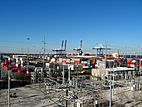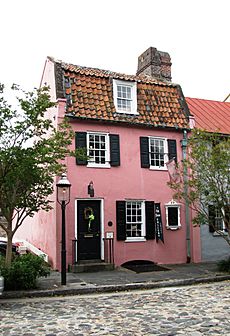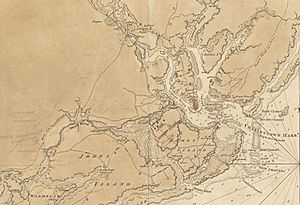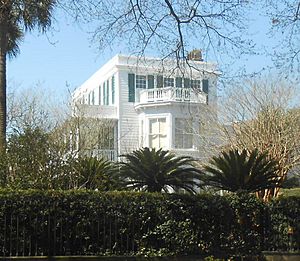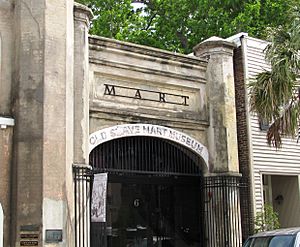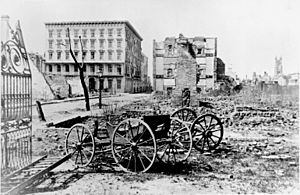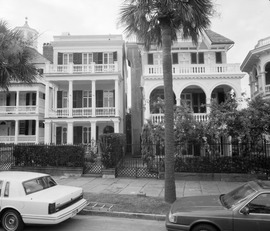Charleston, South Carolina facts for kids
Quick facts for kids
Charleston
|
|||
|---|---|---|---|
|
|
|||
|
|||
| Nickname(s):
The Holy City
|
|||
| Motto(s): | |||
| Country | United States | ||
| State | South Carolina | ||
| Counties | Charleston, Berkeley | ||
| Founded | 1670 | ||
| Chartered | 1783 | ||
| Named for | Charles II of England | ||
| Government | |||
| • Type | Mayor–council | ||
| Area | |||
| • Total | 135.51 sq mi (350.97 km2) | ||
| • Land | 115.03 sq mi (297.93 km2) | ||
| • Water | 20.48 sq mi (53.04 km2) 15.11% | ||
| Elevation | 20 ft (6 m) | ||
| Population
(2020)
|
|||
| • Total | 150,227 | ||
| • Estimate
(2023)
|
155,369 | ||
| • Rank | 174th in the United States 1st in South Carolina |
||
| • Density | 1,305.97/sq mi (504.24/km2) | ||
| • Urban | 684,773 (US: 63rd) | ||
| • Urban density | 2,019.6/sq mi (779.8/km2) | ||
| • Metro | 849,417 (US: 71st) | ||
| • Demonym | Charlestonian | ||
| Time zone | UTC−5 (EST) | ||
| • Summer (DST) | UTC−4 (EDT) | ||
| ZIP Codes |
29401–29407, 29409–29410, 29412–29420, 29422–29425, 29492
|
||
| Area codes | 843, 854 | ||
| FIPS code | 45-13330 | ||
| GNIS feature ID | 1221516 | ||
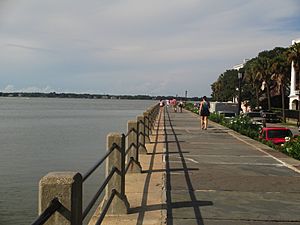
Charleston is the largest city in the U.S. state of South Carolina. It is the main city in the Charleston metropolitan area. The city is located on Charleston Harbor, where the Ashley, Cooper, and Wando rivers meet the Atlantic Ocean. In 2020, Charleston had a population of over 150,000 people. The larger Charleston area, including nearby counties, had about 849,000 people in 2023. This makes it the third-largest metropolitan area in South Carolina.
The British founded Charleston in 1670. They named it Charles Town after King Charles II. It was first built on the Ashley River, but moved to its current spot in 1680. Within ten years, it became the fifth-largest city in North America. Charleston officially became a city in 1783 and changed its name to Charleston. Even though the state government moved to Columbia in 1788, Charleston remained one of the ten largest cities in the U.S. until the 1840s.
Charleston was a very important port for the slave trade. Many enslaved people brought to the United States arrived in Charleston. In 2018, the city formally apologized for its role in this trade.
Contents
History of Charleston
Early Days (1670–1776)
In 1663, King Charles II gave the land of Carolina to eight friends, called the Lords Proprietors. In 1670, settlers from Bermuda and Barbados arrived. They started Charles Town at Albemarle Point, a few miles from today's city center. This was the first planned town in the Thirteen Colonies.
The first settlement moved in 1680 to Oyster Point, where the Ashley and Cooper rivers meet. This new spot was easier to defend and had a great natural harbor. By 1690, it was the fifth-largest city in North America.
The town faced challenges like smallpox outbreaks, an earthquake, and yellow fever. These events caused many people to get sick or die. Charleston became known as one of the least healthy places for Europeans in the colonies.
Charles Town was protected by walls built in 1704. Both Spain and France wanted control of the area. Native American groups and pirates also attacked the town. In 1718, the pirate Blackbeard even held the city under siege for several days.
By 1719, people started writing the town's name as Charlestown. The old walls were mostly taken down. Charlestown became a key center for settling inland South Carolina. Many early settlers came from Europe, Barbados, and Bermuda. They brought enslaved Africans with them from the West Indies.
Other groups also moved to the city, including Huguenots (French Protestants), Scottish, Irish, and Germans. Hundreds of Jewish people also settled here, mostly from London and the Netherlands. By 1830, Charleston had the largest and wealthiest Jewish community in North America.
By 1708, most people in the colony were Black Africans. They were brought to Charlestown through the Atlantic slave trade. Charleston became a major port for this trade. About 40% of all enslaved people brought to North America landed at Sullivan's Island near Charlestown.
The city's economy grew around trading deerskin and later, rice and indigo. These crops were grown on large farms called plantations, which relied on enslaved labor. This made Charleston a very wealthy city. By 1770, Charleston had 11,000 people, with half of them being enslaved. It was the 4th-largest port in the colonies.
American Revolution (1776–1783)
Charleston played a big part in the American Revolutionary War. South Carolina declared its independence from Britain in 1774. The British tried to capture Charleston three times. They thought many people in the city would support them. However, many white Southerners did not support the British. The British also offered freedom to enslaved people who joined their side, which made many enslaved people support the British.
In 1776, the British tried to capture Fort Moultrie on Sullivan's Island. They failed, and this victory is still celebrated as Carolina Day.
In 1780, Sir Henry Clinton led a large British force to besiege Charleston. The American forces, led by Benjamin Lincoln, were outnumbered. Lincoln surrendered on May 12, 1780. This was a major defeat for the Americans during the war.
The British held Charleston for over a year. They finally left in December 1782. Before leaving, they burned many public buildings and warehouses. American troops then moved into the city.
After the Revolution (1783–1861)
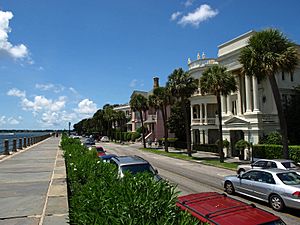
After the Revolutionary War, Charleston's economy grew, especially for the wealthy. The invention of the cotton gin in 1793 made cotton farming much more profitable. Cotton became Charleston's main export. This brought great wealth to some, but also increased the demand for enslaved people.
In 1783, Charleston officially became a city. Even though Columbia became the state capital in 1788, Charleston continued to be very important.
Charleston remained the only major American city with a majority of enslaved people. Enslaved people worked in many jobs, from servants to market sellers. Even some free Black people owned slaves if they could afford them. The city had strict rules for both enslaved and free Black people. For example, in 1820, a law made it very hard to free a slave.
In 1822, Denmark Vesey, a free Black preacher, planned an uprising to escape to Haiti. The plan was discovered, and many Black people were arrested and punished. As a result, the city made even stricter laws. Black people were not allowed to learn to read, gather in groups, or play drums.
In 1838, a huge fire destroyed over 1,000 buildings in Charleston. When the city rebuilt, many new buildings were constructed in the Greek Revival style. This made Charleston famous for its beautiful architecture.
The slave trade continued to be very important. Even though importing slaves from Africa was banned in 1808, the trade of enslaved people within the U.S. grew. Charleston was a major port for this domestic trade.
Civil War (1861–1865)
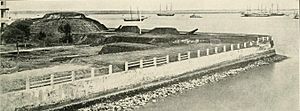
Charleston played a central role in the American Civil War. After Abraham Lincoln was elected president, South Carolina decided to leave the Union on December 20, 1860. It was the first state to do so.
The first battle of the Civil War happened in Charleston Harbor on April 12, 1861. Confederate forces fired on the U.S. Army-held Fort Sumter. After 34 hours, the fort surrendered.
During the war, Union ships often attacked the city, causing a lot of damage. The Union navy also blocked the harbor, stopping most trade. In February 1864, the submarine H.L. Hunley attacked a Union ship.
Confederate forces left Charleston on February 17, 1865, burning many buildings before they left. Union troops then took control of the city.
After the War (1865–1945)
Reconstruction Era
After the Civil War, federal troops stayed in Charleston during Reconstruction. The city's economy was badly damaged. However, the African-American population grew as freed people moved from the countryside. Black people quickly started their own churches and gained more freedoms. Many educated Black leaders from before the war became important in South Carolina's Republican Party.
By the late 1870s, new industries helped the city's economy improve. New jobs brought more people to Charleston. Schools like the Avery Normal Institute were started to educate African Americans.
1886 Earthquake
On August 31, 1886, Charleston was hit by a very strong earthquake. It damaged 2,000 buildings and caused a lot of money in damage. The earthquake was felt in many distant cities.
Charleston Race Riot of 1919
In 1919, a race riot took place in Charleston. Members of the U.S. Navy attacked local Black people, businesses, and homes. Six people were killed and many more were injured.
Modern Charleston (1945–present)
Charleston's economy struggled for a few decades in the 20th century. However, a large military presence helped the city. Tourism also grew, especially after a book about Charleston's architecture was published in the 1920s.
The Charleston Hospital Strike in 1969 was a major event in the civil rights movement. Mostly Black workers protested unfair treatment and low pay. Important civil rights leaders like Coretta Scott King came to support them.
In 1989, Hurricane Hugo hit Charleston Harbor. It caused a lot of damage to homes and buildings. However, the city recovered quickly and its population grew. In 1996, the Charleston Naval Shipyard closed, which was another economic challenge.
In recent years, many white people have moved back to downtown Charleston. This has led to higher prices and rents. Many African Americans have moved to more affordable suburbs.
In 2018, the Charleston City Council formally apologized for the city's role in the slave trade. They also recognized the wrongs committed against African Americans.
Geography of Charleston
Charleston is made up of six main areas:
- Downtown, also called "The Peninsula," is between the Ashley River and the Cooper River.
- West Ashley is a residential area west of Downtown.
- Johns Island is in the far western part of Charleston.
- James Island is a popular residential area between Downtown and Folly Beach.
- Cainhoy Peninsula is in the far eastern part of Charleston.
- Daniel Island is a residential area north of downtown, between the Cooper and Wando rivers.
Land and Water
Charleston has grown a lot over the years. It now includes areas across the Ashley River, like James Island and parts of Johns Island. It also expanded across the Cooper River to include Daniel Island and the Cainhoy area. The city covers about 135 square miles, with about 20 square miles of water.
Charleston Harbor is about 7 miles long and 2 miles wide. Sullivan's Island is to the north of the harbor entrance, and Morris Island is to the south. The harbor entrance is about 1 mile wide. The rivers around Charleston are tidal, meaning their water levels change with the ocean tides.
Climate and Weather
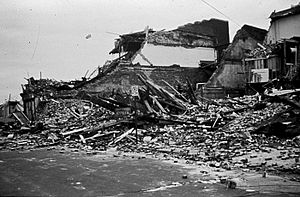
Charleston has a humid subtropical climate. This means it has mild winters and hot, humid summers. It rains a lot throughout the year, especially in summer. Thunderstorms bring almost half of the yearly rainfall from June to September.
Winters are short and mild, with occasional rain. Snow is rare, happening only about once every ten years. Freezing rain is more common.
The highest temperature recorded in Charleston was 104°F (40°C). The lowest was 7°F (-14°C). Hurricanes are a big threat in summer and early fall. Hurricane Hugo in 1989 was a very strong storm that caused a lot of damage.
Charleston Metropolitan Area
The Charleston metropolitan area includes Charleston, Berkeley, and Dorchester counties. In 2020, this area had about 799,636 people. North Charleston is the second-largest city in this area, and Mount Pleasant and Summerville are also large cities.
Culture in Charleston
Charleston's culture is a mix of Southern U.S., English, French, and West African influences. The downtown area has many places for arts, music, food, and fashion.
Festivals and Events
Charleston hosts many annual events:
- Spoleto Festival USA is a 17-day arts festival with over 100 performances.
- The Piccolo Spoleto festival happens at the same time, featuring local artists.
- Other events include the Taste of Charleston, The Lowcountry Oyster Festival, and the Cooper River Bridge Run.
- Charleston Fashion Week showcases designers.
- The MOJA Arts Festival celebrates African-American and Caribbean arts.
Music Scene
The Gullah community has greatly influenced Charleston's music, especially early jazz music. Charleston's music has also influenced the rest of the country. For example, the "Charleston" dance craze of the 1920s was inspired by rhythms from Charleston's dock workers.
The Jenkins Orphanage in Charleston taught music to boys. Many of these musicians became very skilled and played in famous bands. The Jenkins Orphanage Band even played for Presidents Theodore Roosevelt and William Taft. They also performed on Broadway for the play "Porgy," which was set in Charleston. Later, this play became the famous opera Porgy and Bess.
Live Theater
Charleston has a lively theater scene. America's first theater building was built here. Some of the city's theaters include:
- Dock Street Theatre, home to the Charleston Stage Company.
- Queen Street Playhouse, home of the Footlight Players.
- Sottile Theater, on the College of Charleston campus.
Museums and Attractions
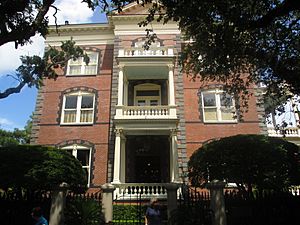
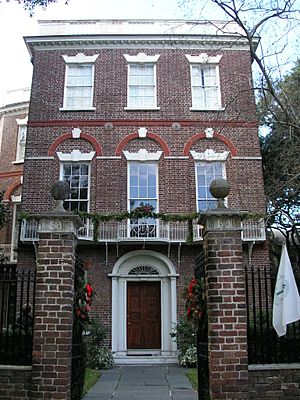
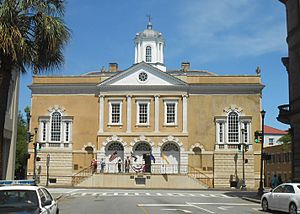
Charleston has many historic buildings, museums, parks, and other attractions:
- Avery Research Center for African American History and Culture collects and shares the history of African Americans in Charleston.
- The Battery is a historic seawall and promenade with a park called White Point Garden.
- Charleston Museum, founded in 1773, is America's first museum.
- Fort Sumter, where the first shots of the Civil War were fired, is in Charleston Harbor.
- International African American Museum, opened in 2023, tells the story of African Americans.
- Market Hall and Sheds is a busy commercial area with shops and vendors.
- Old Slave Mart Museum is the first African American Museum, operating since 1938.
- Powder Magazine is a 1713 building that stored gunpowder and is now a museum. It's the oldest public building in South Carolina.
- Rainbow Row is a famous row of colorful historic houses along the harbor.
- South Carolina Aquarium focuses on the aquatic life of South Carolina.
- Waterfront Park is a popular park on the Cooper River.
Sports Teams
Charleston is home to several sports teams:
- Charleston Battery, a professional soccer team.
- Charleston RiverDogs, a Minor League Baseball team.
- South Carolina Stingrays, a professional hockey team.
Economy of Charleston
Commercial shipping is very important to Charleston's economy. The city has two shipping terminals, which are part of the fourth-largest container seaport on the East Coast. The port also handles cars and car parts for companies like Mercedes and Volvo.
Charleston is also becoming a hub for high tech and innovation, sometimes called Silicon Harbor. This sector has grown quickly. The Milken Institute ranked Charleston as one of the best-performing economies in the U.S. because of its growing technology industry.
Top Employers
The largest employers in the Charleston area include:
- Joint Base Charleston (military base)
- Medical University of South Carolina
- Boeing South Carolina (airplane manufacturing)
- Roper St. Francis Healthcare
- Charleston County School District
Transportation in Charleston
Airport and Rail
Charleston is served by the Charleston International Airport, located in North Charleston. It is the busiest airport in South Carolina. A smaller airport, Charleston Executive Airport, is used for noncommercial flights.
Amtrak trains also serve Charleston, with two daily trains stopping at the Amtrak station in North Charleston.
Highways and Bridges
I-26 starts in Downtown Charleston and connects the city to North Charleston, the airport, and other major interstates. US 17 travels through Charleston and Mount Pleasant. I-526 is a bypass around the city.
Arthur Ravenel Jr. Bridge

The Arthur Ravenel Jr. Bridge opened in 2005. It crosses the Cooper River and connects downtown Charleston with Mount Pleasant. When it was built, it was the longest cable-stayed bridge in the Americas. The bridge has eight lanes for cars and a separate lane for walkers and bikers. It replaced two older bridges that were considered dangerous.
Bus Service
The city has a bus system called CARTA. It serves most of the urban area with regular bus routes. CARTA also has trolley buses for downtown attractions and special services for disabled passengers. A new bus rapid transit system is being developed to connect Charleston to Summerville.
Port of Charleston
The Port of Charleston is one of the largest ports in the United States. It has six terminals and is ranked among the top ports for containerized cargo. The port is a major source of income for the city, second only to tourism.
The Port of Charleston has the deepest water in the Southeast region. This allows it to handle very large ships. A project to deepen the harbor channel was completed, making it 52 feet deep at low tide.
The Union Pier Terminal in Charleston used to host many cruise ship departures. Currently, cruise operations are paused. The Detyens Shipyard, a large commercial ship repair facility, also operates in Charleston.
Education in Charleston
Most of Charleston is served by the Charleston County School District. Some northern parts of the city, like Daniel Island, are served by the Berkeley County School District.
Charleston also has many private schools, including Porter-Gaud School, Charleston Collegiate School, and Ashley Hall. The Roman Catholic Diocese of Charleston also runs several schools.
For higher education, Charleston has:
- College of Charleston
- The Citadel, The Military College of South Carolina
- Medical University of South Carolina
- Charleston Southern University (private)
- Charleston School of Law (private)
- The American College of the Building Arts, which offers degrees in building arts.
Notable People from Charleston
Many famous people have come from Charleston, including:
- Akim Anastopoulo, a TV personality and lawyer.
- Madelyn Cline, an actress from the TV series Outer Banks.
- Stephen Colbert, a comedian and host of The Late Show.
- Shepard Fairey, a well-known graffiti artist.
- Robert F. Furchgott, who won the Nobel Prize in Medicine.
- Thomas Gibson, an actor from Criminal Minds.
- Fritz Hollings, a former U.S. Senator and Governor of South Carolina.
- Robert Jordan (James Oliver Rigney Jr.), a fantasy author known for The Wheel of Time series.
- John Laurens, a lieutenant colonel in the American Revolutionary War.
- Khris Middleton, an NBA basketball player and Olympic gold medalist.
- Darius Rucker, a country music artist and former member of Hootie & The Blowfish.
- Robert Smalls, an African American Civil War hero, businessman, and politician.
- Denmark Vesey, a revolutionary who planned an uprising.
- Joseph Wragg, a pioneer in the large-scale slave trade.
Sister Cities
Charleston has several sister cities around the world:
 Doha, Qatar
Doha, Qatar Freetown, Sierra Leone
Freetown, Sierra Leone Panama City, Panama
Panama City, Panama Speightstown, Barbados
Speightstown, Barbados Spoleto, Italy
Spoleto, Italy Flers, France
Flers, France
The relationship with Spoleto, Italy, began because Gian Carlo Menotti chose Charleston to host the American version of Spoleto's arts festival. Charleston was a perfect fit because of its charm and many performance spaces.
Charleston is also connected to Speightstown, Barbados. The first settlers designed parts of Charles Town based on Bridgetown, Barbados's capital. Many planters moved their farms and enslaved people from Speightstown to Charleston.
Images for kids
-
A map of the "Several Nations of Indians to the Northwest of South Carolina" or the "Catawba Deerskin Map", an annotated copy of a hand-painted deerskin original made by a Catawba chief for Governor Francis Nicholson. "This map describing the scituation [sic] of the several nations of Indians to the NW of South Carolina was coppyed [sic] from a draught [sic] drawn & painted on a deer skin by an Indian Cacique and presented to Francis Nicholason Esqr. Governor of South Carolina by whom it is most humbly dedicated to his Royal Highness George, Prince of Wales”.
-
Herman Moll's 1733 Town and Harbour of Charles Town in South Carolina, showing the town's defensive walls.
-
Rainbow Row's 13 houses along East Bay Street formed the commercial center of the town in the colonial period.
-
The 1932 monument in the Battery honoring the Confederate defenders of Fort Sumter.
-
Damage left from Hurricane Hugo in 1989.
-
Randolph Hall, College of Charleston.
See also
 In Spanish: Charleston (Carolina del Sur) para niños
In Spanish: Charleston (Carolina del Sur) para niños




